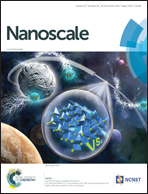Phosphine-free engineering toward the synthesis of metal telluride nanocrystals: the role of a Te precursor coordinated at room temperature†
Abstract
A colloidal strategy offers opportunities for the rational design and synthesis of metal telluride nanocrystals (NCs) with the desired crystal structure, uniform geometry, and composition. However, it remains a challenge to use the paradigm to construct metal telluride NCs by a phosphine-free synthesis procedure for promising applications such as luminescence, photovoltaics and thermoelectricity. Here, we developed a new strategy for fabricating metal telluride nanocrystals, e.g. CdTe and PbTe NCs, by using a highly reactive phosphine-free Te precursor. The ability to reduce a TeO2 powder with dodecanethiol (DDT) has been achieved in the presence of oleylamine (OLA) to generate a soluble alkylammonium telluride at room temperature. We provide direct experimental evidence that the OLA–Te complexes were formed in an order of second magnitude kinetic process based on an in situ UV-vis absorption test. In the case of the CdTe NC system, the straightforward measurement of luminescence and the fabrication of LED devices are presented that can semiquantitatively assess the quality of preparation and the reactivity of this air-stable precursor. The proposed strategy highlights several unique features of this solution-based green chemistry that can be useful for synthesizing other metal telluride NCs to develop novel functional materials.



 Please wait while we load your content...
Please wait while we load your content...